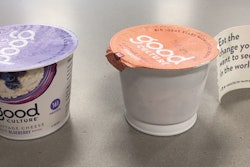
They are increasingly being made within civil class action cases, on behalf of thousands or millions of individual consumers, rather than as enforcement actions by regulators. On behalf of packagers everywhere, please allow me to make this complex legal argument: Such accusations ain’t really fair.
The thing about “slack fill” that it’s useful to remember is that there are lots and lots of proper functions for it. Packaging and production engineers know this, because the requisites and limitations of production or transport or product characteristics or other factors often result in a package with empty space in it. It’s rarely deceptive to consumers, sez me anyway, and even more rarely intended to be deceptive.
FDA’s got a regulation prohibiting nonfunctional slack-fill in foods, defined as “the empty space in a package that is filled to less than its capacity for reasons other than” any of a list of acceptable reasons. It only applies to “A container that does not allow the consumer to fully view its contents.”
Those acceptable reasons include “protection of the contents of the package,” and “the requirements of the machines used for enclosing the contents in such package,” and “unavoidable product settling during shipping and handling” (looking at you, breakfast cereal). The regulation even accounts for packages serving specific functions for preparing food, reusable containers, and other practical purposes. For full details see the regulation, 21 CFR Sec. 100.100.
Even the Fair Packaging and Labeling Act, which applies more broadly to consumer commodities, allows for regulations to protect against nonfunctional slack fill, which it defines as a package that “is filled to substantially less than its capacity for reasons other than (A) protection of the contents of such package or (B) the requirements of machines used for enclosing the contents in such package.”
In other words, the law recognizes there are many circumstances that could cause empty space in a package. It also recognizes that many of those circumstances are perfectly legitimate and do not create a package that is misleading. The tough part for packagers is that what’s OK per federal regulations may not necessarily be OK per a state law.
A recent court decision said properly stating the quantity of contents does not absolve a company of liability for a potentially deceptive container.
If the real problem with non-functional slack fill is that it misleads consumers, it’s logical to think that as long as the package is properly labeled with the net quantity of contents, then any slack fill in it can’t be considered deceptive, even if it is non-functional. After all, the net quantity of contents appears, if it’s displayed as required by FDA regulations, right there near the bottom of the front of package, in nice big type size for all the world to see.
FDA regulations include a number of specific requirements for how to display the statement of the net quantity of contents on a food label. It needs to be displayed on the principal display panel, in the bottom 30% of the panel, in lines generally parallel to the base, and the minimum type size is specified, and is proportionate to the size of the package.
Well, in a still-pending class action case against Mondelez International, Inc., a class action plaintiff alleged that the company filled boxes of its Sour Patch Watermelon Candy with only enough candy to fill about half of the box, thereby misleading consumers, in violation of a New York State consumer protection law.
Mondelez made the argument that the box wasn’t misleading because the quantity of contents was properly revealed on the label, and pointed the court to earlier decisions under California law that found that “food packaging cannot be materially misleading so long as it displays the net weight and lists the number of pieces inside the package.”
Alas, the court rejected that argument, saying that its interpretation was that a company had 2 separate legal obligations, first, to label the contents accurately and second, to package products in a non-misleading way. The court quoted FDA as saying that “to rule that an accurate net weight statement protects against misleading fill would render the prohibition against misleading fill…redundant.”
It also took note of another argument Mondelez made, that the box isn’t misleading because consumers “can plainly feel and hear the existence of empty space in the box upon reasonable inspection.” (The candy boxes here were closed and opaque.)
The court didn’t resolve the issue of whether the box was misleading as such, because courts don’t decide factual issues at early stages when they are deciding whether the case can go forward or not. And, interestingly, the court in the Mondelez case decided the case could not go forward, and it threw out the plaintiffs’ claims for other reasons, including their failure to adequately allege they had suffered damages.
In that New York case, the plaintiffs might try to amend their allegations and file the case again. We’ll see. But it’s already clear that, if slack fill claims continue to proliferate, predicting their outcome will be more difficult given that cases brought under different state laws won’t all necessarily follow the same logic or principles.
Let’s hope the many legitimate reasons for the existence of slack fill, and the fact that it doesn’t usually mislead consumers, don’t get lost in a cloud of legal arguments.
Eric Greenberg can be reached at [email protected],or visit his firm’s Web site at www.ericfgreenbergpc.com.
Hear Eric Greenberg’s podcast of this month’s column at pwgo.to/3185.
INFORMATIONAL ONLY, NOT LEGAL ADVICE.

























